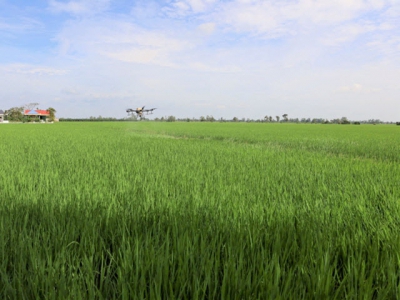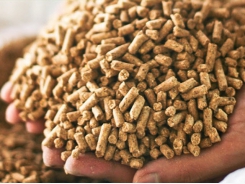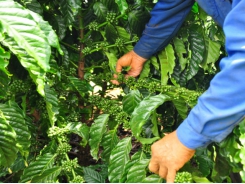Applying SRP standards in production produces quality rice

Many provinces in the Mekong Delta have applied the SRP standards in rice production that have yielded bumper crops with high quality rice to supply to the market.
Production according to SRP standards is a new trend in the Mekong Delta provinces based on the production in the direction of "3 decrease, 3 increase" and "1 right, 5 decrease".
SRP standard set of 41 criteria and 12 indicators
The SRP Standards are the world's first set of standards for sustainable rice production, including 41 criteria and 12 performance indicators related to profitability, labor productivity, water quality, sustainability, biodiversity, greenhouse gas emissions, food safety, health and labor safety...
Five years after its launch in 2017, over 1,500 farmers have participated in the “Development of Sustainable and Inclusive Rice Value Chain for smallholder producers in Vietnam” program while the rice cultivating area applying SRP standards in the Mekong Delta has increased from 25ha to 4,300ha.
Meanwhile, 100% and 92.5% of rice farmers in Dong Thap and Kien Giang Provinces respectively have achieved above 80 SRP points in the 2021 winter-spring crop.
By the end of the winter-spring crop in 2021, 343 farmers outside the program have voluntarily applied SRP standards in cultivation.
By applying the SRP model, farmers are estimated to reduce 12% of production costs per hectare, equivalent to nearly 3 million VND compared to the previous models, mainly due to the reduction in the amount of pesticides, fertilizers and labor.
In addition, farmers have also changed their awareness and production practices such as changing the practice of burning straw, saving water, reducing pesticide residues, applying alternate wet-dry irrigation techniques, integrated disease management, contributing to environmental protection and health assurance for producers and consumers.
In Dong Thap alone, only 0.8% of farmers had still burnt rice straw by October 2021. Such activities have also contributed to the implementation of the national strategy on green growth and the National Action Plan on adaptation to climate change.
Production according to SRP standards is a new trend in the Mekong Delta provinces based on the production in the direction of "3 decrease, 3 increase" and "1 right, 5 decrease". The approach aims to help farmers manage irrigation water, improve efficiency in the use of fertilizers and pesticides when applying integrated pest management (IPM) processes, so that rice production will adapt well to changing conditions and climate change, opening a new direction to develop a sustainable agriculture and increase economic value.
According to Ngo Thanh Hung, Director of the Rural Development Sub-Department of Dong Thap Province, the application of the SRP model in recent years has helped Dong Thap farmers to change their traditional rice farming practices by applying new scientific and technical advances to production and thereby promoting the participation of women and youth in the rice value chain.
Producing rice production according to SRP standards, farmers are not allowed to burn rice straw and at the same time, they have to combine inorganic and organic fertilizers, manage integrated pest according to the "4 right" principle, wear labor protection on spraying pesticides while newly sprayed fields must put up a notice board, which helps to protect the environment.
The SRP model helps to reduce production costs from 2.5 to 3 million VND/ha. Rice produced according to the model meets export standards and the needs of affiliates.
“Farmers participating in the SRP model are regularly supported with training in farming techniques and participating cooperatives are supported in seeds, fertilizers, and pesticides,” said Nguyen Thi Xuan Huong, Agriculture Extension Center of Kien Giang province.
“Viet Nam’s SRP model is a key model of a green agriculture that produces high quality rice, increases farmers’ income, protects the environment and both producers and consumers’ health,” she added.
Effective SRP rice farming models
Since 2018, farmers in Thang Loi Commune, Thap Muoi District, Dong Thap Province have received support from the international NGO Rikolto (Belgium), a member of the Sustainable Rice Forum, on applying SRP standards in sustainable rice production.
"I only need to use 6kg of seed rice instead of 20kg like before on 1 hectare of cultivating area, but could still have the same yield and quality on 1 unit of area,” said Nguyen Van Khi, a farmer having 8 hectares of rice cultivation.
Not only saving costs on varieties, the SRP standards have also significantly reduced the amount of fertilizers and pesticides as the farmers are instructed to spray pesticides with the right type, at the right time and at the right dose... To control the farming process, farmers must keep a diary of production.
It also helps farmers to easily calculate production costs and profits. After harvesting, straw will not be burned but used as agricultural by-products, which makes a maximum contribution to environmental protection.
Representatives of the Agricultural Service Cooperative of Thang Loi Commune (Thap Muoi District, Dong Thap Province), which is the output off-taker for local farmers, also affirm the benefits of farmers when participating in the model of growing rice according to SRP standards. Farmers no longer have to worry about output because the quantity of clean rice would be consumed by the cooperatives at a stable price or higher than the market.
"The most important benefit of the model is environmental protection as it reduces the times of spraying pesticides from six to four times this crop. There have been no more burning fields after harvest while the water source after spraying is far from the canals,” said Nguyen Van Hung, Director of the cooperative.
By now, over 97% of farmers in Dong Thap Province have participated in the model of rice cultivation according to the SRP standard, reaching from 80-89 points.
100% of rice farmers in Dong Thap and 92.5% in Kien Giang have achieved more than 80 SRP points in the winter-spring crop of 2021. The number of cultivated areas from 80-89 points has also reached nearly 90%.
Related news
Tools

Phối trộn thức ăn chăn nuôi

Pha dung dịch thủy canh

Định mức cho tôm ăn

Phối trộn phân bón NPK

Xác định tỷ lệ tôm sống

Chuyển đổi đơn vị phân bón

Xác định công suất sục khí

Chuyển đổi đơn vị tôm

Tính diện tích nhà kính

Tính thể tích ao



 Developing a green and sustainable agriculture
Developing a green and sustainable agriculture  VnSAT promotes coffee industry development in the Central…
VnSAT promotes coffee industry development in the Central…